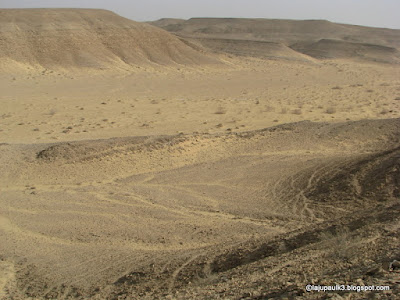On behalf of Midrasha Hiking club, we had a 12 km hike through the Valley of Uvda, walking through some unique sites including a beautiful sand dune, a mysterious 9,000 year old temple dedicated to Leopards and much more ancient pre-historic remains dispersed everywhere. Uvda Valley has over 150 settlement sites dating between 10,000 and 6,000 years ago throughout the valley. The region also is considered to be the oldest agricultural land in the history of mankind. Although, today you find the valley part of a harsh desert, ancient remains from past throw light into the once highly fertile strip. More from the photographs appended...
Experience the most vibrant,amazing yet unpredictable strip of land on earth.
Wednesday, April 28, 2010
The Ramon Crater (1P-4P) and Paran Desert (5P)-on the way to Uvda Valley.
5P: Paran Desert: Mentioned in the Holy Bible 11 times. The region where:
1) Ishmael is said to have settled after his separation from Abraham (Genesis 21:21).
2) Israelites spent part of their 40 yrs exodus (Numb. 10:12; 12:16; 13:3, 26; Deut. 1:1).
3) King David spent time after Samuel died (I Samuel 25:1).
4) Edomite Hadad stopped when fleeing before King Solomon (I Kings 11:18).
5) Word of God came from (Deuteronomy 33:2; Habbakuk 3:3).
The Rose of Jericho or Resurrection Plant (Anastatica hierochuntica) from Uvda Valley.
Wikipedia lists many other names for the Rose of Jericho such as dinosaur plant, Jericho rose, Mary's flower, Mary's hand, Palestinian tumbleweed, resurrection plant, St. Mary's flower, true rose of Jericho, and wheel. Legends has it that Virgin Mary clenched this plant while giving birth to Jesus. Another tradition says that while the Holy Family fled through the desert from Judea to Egypt, Virgin Mary was impressed with the magnificent qualities of the Rose of Jericho and blessed it. It is also identified with the "wheels" mentioned in Psalms 83:13 ("O my God, make them like a wheel; as the stubble before the wind").
In nature, the plant lives in absolute desert conditions with meagre amount of water to survive with and appears as a dead dry mass of ball. As soon as it receives water, within a a short time it will open up, and spread its branches like the fingers of a hand – wide open! Just as if it had returned to life. When the conditions become dry it will shrink again and close its "fingers" and return to the dry state. This action can be repeated for over 20 years! No wonder why it is called the Resurrection Plant.
The good news is that you can today buy the plant and keep in your living room and observe the resurrection process for years. You can find many online stores selling "Rose of Jericho" for a price 20-25$! We just picked one of the plant from the Uvda valley and immersed in a bowl with water and found that it bloomed in approximately 30 minutes. Also it returned to its dry state when the water was removed. Yes the resurrection works. Find the pictures below.
BEFORE RESURRECTION

AFTER RESURRECTION
7P: I need to identify this plant below.
LEOPARD TEMPLE, UVDA VALLEY. 9,000-YEAR-OLD
A mysterious 9000-year-old temple dedicated to leopards is an unique attraction from Uvda Valley. A total 16 leopards are beautifully carved on earth with ancient stones. All the leopards are directed towards East-the direction of sunrise and probably designating victory. Among the leopards one can also observe a prey, probably an ibex. Strangely, the head of ibex is directed towards west-the direction of sunset and perhaps indicating submissiveness. No one knows to whom the temple is dedicated and who built it, but for sure it happened to be a very special place. Thanks to the the remoteness of the site, the temple remained untouched by human hands for thousands of years, until it was rediscovered recently.
Subscribe to:
Comments (Atom)










































